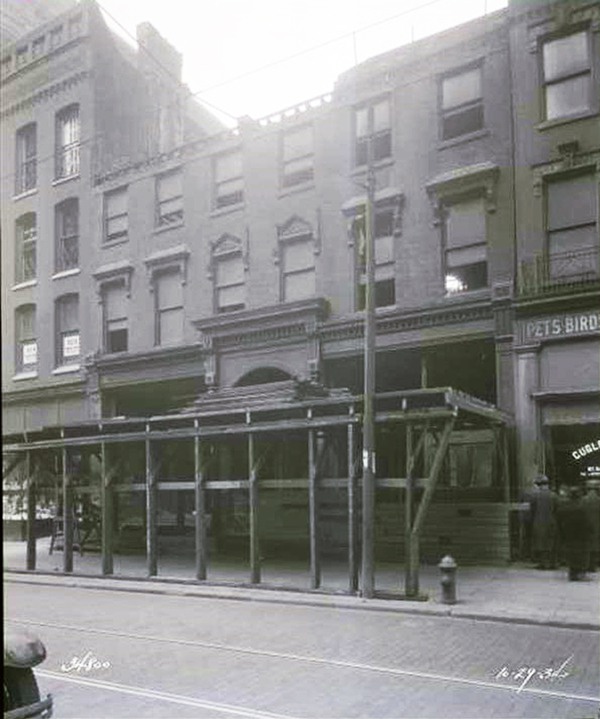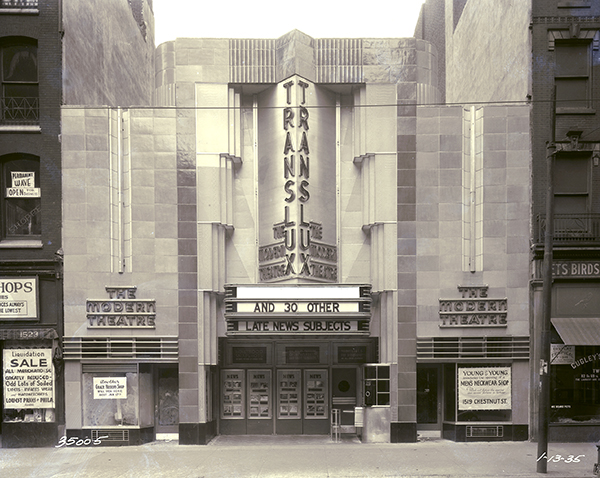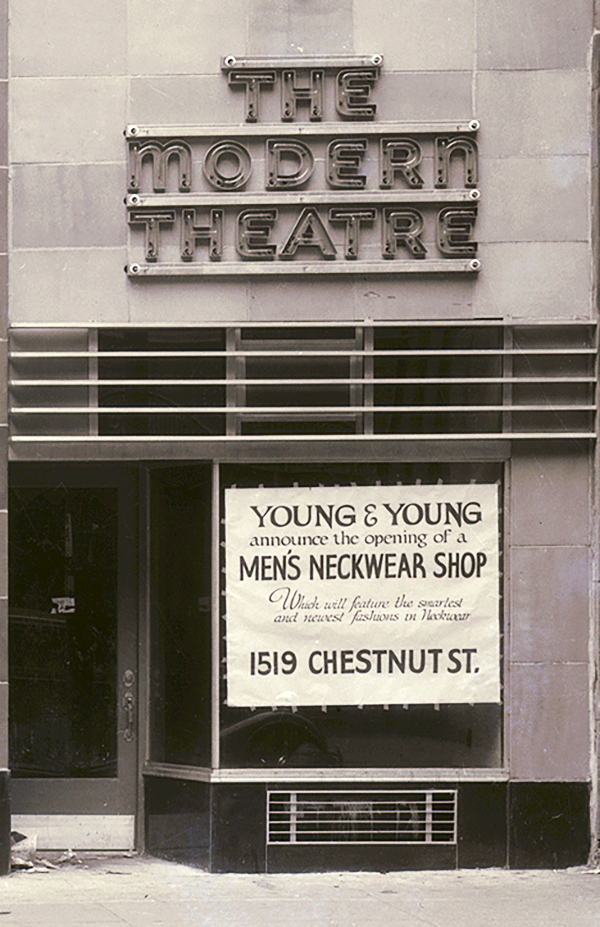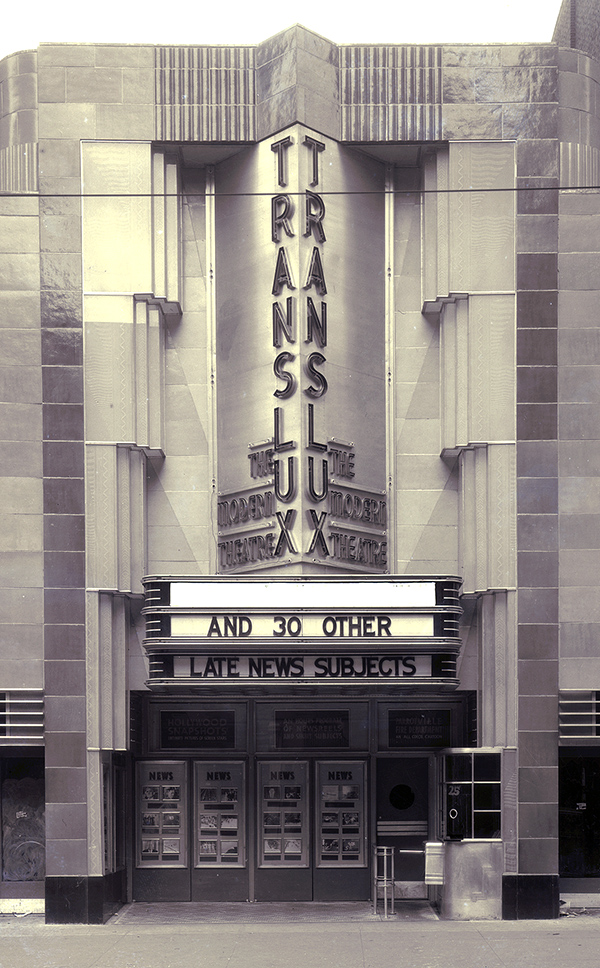”A brand new idea in motion picture theaters here was launched last night,” boasted Inquirer film critic Mildred Martin. In the depths of the Great Depression, this brand new “intimate auditorium,” an Art Deco confection called the Trans-Lux, promised to transform traditional movie goers into 20th-century citizen-spectators.
Instead of screening Hollywood’s latest feature films, the Trans-Lux offered newsreels and other short films in a “small but charming and modernistic house seating only 493.” Relying on a counter-intuitive business plan that had recently proven itself in Manhattan, here was a distinct departure from gigantic, lavish movie palaces like the Boyd, the Stanley and the Mastbaum, with 2,500 seats, 2,916 seats and 4,700 seats, respectively.
Entering architect Thomas W. Lamb’s gleaming, streamlined design, patrons literally crossed the threshold of the latest media culture, participating in cutting-edge design, bleeding-edge technology, and up-to-the moment news.
“The new theater’s architecture, decoration and mechanics are all entirely modern,” wrote Martin. “There is no projection booth in the balcony. Everything – projectors, films, electric wiring, operator – is behind the screen. Special lighting effects flood the Trans-Lux Theatre with a soft glow which makes empty seats clearly visible. No tripping over legs in the gloom, no waiting for ushers, no hunting for lost hats, no worry about the safety of children because the theater is so well lighted.” Amenities included “attractive mezzanine lounge[s] with modernistic effects… telephone booths and other conveniences.”
“Selected from the entire short subject output of all motion picture producers in America and foreign markets” newsreels at the Trans-Lux quadrupled what was available at “the average feature picture house.” Patrons viewed “a wide variety of topics” including “comedy, animal life, sports, cartoons, travelogues and novelty material of entertainment and educational value.” And they were offered hard news.
Beginning in 1935, this included newsreels under The March of Time brand, stories like the Dionne quintuplets, hobbies of Hollywood stars, and animated cartoons featuring Jack Frost and Popeye the Sailor. Regulars returned weekly for the latest adventure of Amelia Earhart, automobile racing accidents, and highlights bound for sporting history. And at the heart of every sixty-to-ninety-minute presentation was at least one newsreel of note.
In November 1935, this would be a 7-minute, 50-second March of Time production entitled Palestine (East of the Suez) that credited Adolph Hitler, “who has wrought upon Jews more evil than any man of his generation” with a wave of immigration from Germany to the Middle East.
“Fanned by the oratory of Hitler’s minister of propaganda, [Joseph] Goebbels, anti-semitism has swept Germany,” the narrator continued. “All books of Jewish authors are ordered burned in public squares. Authors, scientists, artists are driven from Germany. Bands of loud Nazi youth in storm trooper uniforms conduct terrorizing raids on Jewish citizens throughout the land, to the rest of the world’s shocked amazement.” Authentic film clips illustrated every line.
“These are the final blows of a long persecution which has been forcing Jews out of Germany by tens of thousands,” read the announcer. “World attention and sympathy for such refugees as Dr. Albert Einstein welcomed in America, has obscured the plight from Germany of some 80,000 German Jews to all parts of the world … 6000 to America, 23,000 to Palestine. . . . a new Palestine and the land of promise.”
In Ohio, a board of motion picture censors deemed some segments “irrelevant” and “anti-Nazi.” E. L. Bowsher, the state’s chief censor, forced theaters “to cut 150 feet of film” from each copy of the newsreel.
No censorship was reported at Philadelphia’s Trans-Lux, which was about to complete its first year. At that anniversary, Trans-Lux manager William Matteson praised “Philadelphia’s interest in a theatre devoted exclusively to newsreels and short subjects” adding “we are happy to state that our experiment has proved entirely successful.”
Before long, Trans-Lux chain was operating in a dozen cities.
In 1938, when The March of Time produced a16-minute news feature entitled Inside Nazi Germany, criticism came from all sides. According to film studies historian Joseph Clark, Inside Nazi Germany “was denounced as both pro-Nazi and anti-German propaganda.” The Warner Brothers chain of theatres refused to screen it. At the Trans-Lux Theatre in New York’s Time Square, according to Clark, “there were a few ‘Heils’ for Hitler and an opposing and equivalent number of ‘Pfui,’” and some fist-waving audience members had to be separated.” But Inside Nazi Germany was not censored there Quite the opposite. Trans-Lux executives introduced the newsreel on the night of January 20, 1938 with the following projected on the screen:
“NOTICE. The issue of March of Time you are about to see has caused much controversy. Our policy is to fearlessly present any worthy film released by a recognized American producer. We therefore present uncensored and impartially the following subject.”
Fifty-five years later, The Library of Congress designated Inside Nazi Germany as “culturally significant” and added it to the United States National Film Registry for preservation in perpetuity. The newsreel also survives online. But Philadelphia’s Trans-Lux theatre does not. In the 1950s it became a first run theater. In the 1970s its distinctive vintage façade was replaced.
Today, the building is a sneaker emporium.

Demolition of the Samuel T., Freeman & Co. auction rooms
to make way for the Trans-Lux Theatre.
[Sources: In The Philadelphia Inquirer: “Chestnut St. Site Leased at $500,000 for New Movie.” Aug 31, 1934; “Trans-Lux Theatre Opens Tomorrow,” December 30, 1934; Mildred Martin, Trans-Lux theater has its inaugural, December 31, 1934; “Film Censors Ban Anti-Nazi Scenes,” October 27, 1935; Trans-Lux, “March of Time” [advertisement], November 3 1935; “Trans-Lux Year Old,” December 31, 1935.
The March of Time Newsreels [Synopses]. February 1935 – August 1951. PDF; “Deletion of film brings protest,” Evening Star, Washington D.C. October 27, 1935; March of Time, Volume 1, Episode 7, “Palestine (East of the Suez)” [1935]. Transcript.
Joseph Clark, News Parade: The American Newsreel and the World As Spectacle (University of Minnesota Press, 2020); Raymond Fielding, “Mirror of Discontent: The March of Time and Its Politically Controversial Film Issues,” The Western Political Quarterly , March., 1959, Vol. 12, No. 1, Part 1; URL; Irvin R. Glazer, Philadelphia Theatres, A‑Z: A Comprehensive, Descriptive Record of 813 Theatres Constructed Since 1724 (New York: Greenwood Press, 1986)].




5 replies on “Nazis at the Trans-Lux”
Thanks for another fascinating article.
Thank you, Lou.
I saw the link on Jay Farrell’s Philadelphia Industrial and Commercial Heritage Facebook page. Since 2020, the PH page has been not posting much of anything, except a few corrections once a month, so I haven’t been paying that much attention to it.
Thanks again.
Thanks for the very interesting post. I grew up in Philadelphia. (My mother founded and ran a women’s clothng shop.) I remember the Trans-Lux very well. At my young age then, I probably didn’t appreciate it as much as I would now; its films were mostly too serious. But it’s good to look back on that time when life seemed much less confusing.
I saw the link on Jay Farrell’s Philadelphia Industrial and Commercial Heritage Facebook page. Since 2020, the PH page has been not posting much of anything, except a few corrections once a month, so I haven’t been paying that much attention to it.
Thanks again.